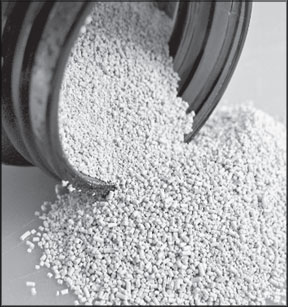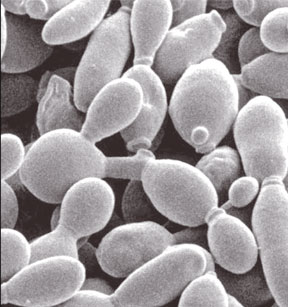|
Health
The rise and rise of YEAST
Tilak Nagodawithana Ph.D
In a country like Sri Lanka where rice has been the staple food for
centuries, it is not surprising to find that the per capita consumption
of bread and for other bakery goods has remained low over the years,
relative to those of developed nations. Yeast, as we well know, is the
key ingredient needed to provide the flavor nuances and the much needed
leavening power to provide the familiar bread matrix. Currently, with
further dwindling bread consumption, the disappointing market potential
it has created for yeast in Sri Lanka, is thus understandable.

Yeast |

Yeast cells |
Following the thirty year war, a handful of entrepreneurs showed
interest to take advantage to fill this void by looking at the
possibility of building production facilities. But all such surveys
carried out stopped in the tracks primarily due to the limited captive
markets in Sri Lanka.
In recent years this situation has further worsened with the increase
of wheat pricing in the world market. An additional issue which can be
less important but nevertheless critical is a possible shortage of
locally produced molasses. This is the substrate for making yeast, and
currently, it is being used extensively for making alcoholic drinks
which ironically, in Sri Lanka has immediate payback.
Currently, the entire supply of yeast and yeast related products are
imported. As a result, there is a substantial foreign exchange drain
which can easily be avoided by investing on yeast production facilities
in areas where sugar cane plantations are expanding. This report,
therefore, is to bring the reader's attention to other far reaching
goals yeast manufacturers in the developed world already have in place,
for increasing their product lines and thereby improving their
profitability.
Yeast is, without doubt, the most important group of microorganisms
commercially exploited and safely consumed by mankind today. Many
authorities believe that Egyptians have discovered the extraordinary
properties of yeast 6000 years ago when some freshly crushed grapes left
exposed to air turned into a pleasant and intoxicating beverage which
they subsequently named as wine.
Early findings
The early "Oenologists" quite accidently found out that when they
carefully scraped the white sediment that precipitated to the bottom of
every batch of wine and added to the next batch of fresh juice, the wine
made second time was as good as the previous batch. After these humble
beginnings, production of wine and subsequently beer developed as an art
and craft in complete absence of scientific know-how.
Legend has it that it did not take too long before some enterprising
baker of flatbread, added a portion of a primitive wine sediment to his
dough, looking to improve its quality. To his surprise, the dough
leavened (puffed) and improved the flavor and texture of flatbread. The
twin arts of baking and wine making and subsequently brewing then became
profitable ventures within communities at the time without any
understanding of the basic principles associated with such processes.
The very existence of the microbial world was unknown to mankind
until the microscope was invented by a Dutch lens grinder, A van
Leeuwenhoek in 1680. He first observed the microbial world when he
examined a drop of fermenting beer through a handmade single lens
microscope. However, the work he brilliantly begun was not extended for
over a century. Finally, in 1850s, Louis Pasture discovered that these
changes in composition of "wine" are as a result of metabolic changes in
sugary media, caused by the action of live yeast. These painstaking
studies by Pasteur followed by his brilliant interpretations of his
results gave to the world the basic knowledge upon which most of our
modern industrial biotechnology has been built.
Yeasts are represented by numerous strains that were chosen and
adapted for specific industrial fermentations. They include Baker's
yeast, wine yeast, top and bottom fermenting brewer's yeast and
distiller's strains used for alcohol production from molasses and other
sugary materials. Strain improvement by conventional methods, genetic
manipulation and protoplast fusion has contributed to superior strains
for the aforementioned processes.
Earliest commercial production of Baker's yeast probably occurred in
Holland around the early 1780s. In their process, sugar solution was
slowly fed to an aerated suspension of yeast and the process was named
as Zulaufer/fahren.
This process was widely accepted by not only the yeast manufacturers
but the entire fermentation industry as an incremental feeding or
fed-batch process. Thus the baker's yeast industry has contributed
greatly to the entire fermentation industry by the introduction of the
fed-batch process which now has wide application in the production of
organic acids, amino acids, enzymes, vitamins, and in the antibiotic
industry.
Stages
In general, there are five to seven stages of propagations,
progressively getting larger in volume with every change of stage, in
the production of Bakers' yeast: the laboratory stage in which the pure
culture from slants is transferred to growth flasks; then to two to
three stages of set batch (substrate and nutrients all in) where the
contents of the preceding stages are transferred via sterile piping to
the succeeding stages of increasing volume; then to two stages of
fed-batch (incremental sugar feeding) fermentations and finally the
commercial stage which often carries 50,000 gallons of fermenting
liquid. The final content is eventually centrifuged, and the separated
cream is pressed and sold as pressed cake or turned to noodles and dried
in air-lift dryers to produce Active Dry Yeast (ADY)
Yeast production is important not only for baking, brewing and
distillery fermentation but also for the production of a variety of
value added products. In this category, the most important segment is
the flavor and flavor enhancing yeast extracts which are gaining immense
popularity in the vastly expanding food industry. Additionally, there is
a high demand for yeast extracts in the fermentation industry as a cost
effective microbial growth nutrient.
Adding yeast extracts to complex media to improve their nutritional
properties is way to reduce the cost of production of a variety of
products such as in the manufacture of drugs, antibiotics, enzymes,
hormones, citric acids, and other important organic chemicals, where
microbial fermentation is the standard production procedure. Additional
to such fermentations, there is a lucrative market for yeast extracts
for the production of starter cultures for the sausage and dairy
processing industries. The volumes of yeast extracts consumed by this
heavily funded fermentation industries are so enormous that it now has
become the most lucrative sector in the yeast and yeast-related
businesses.
In growth media, in order to ensure microbial growth and effective
product synthesis, the composition of the medium must be chosen
carefully. Some industrial organisms require simple nutrients that will
enable to synthesize all or most of the intrinsic organic intermediates
required to sustain life and to allow growth and in the process, produce
useful metabolites. At the opposite end, most industrial organisms
developed more recently from genetic engineering have certain unique
nutrient requirements which yeast extract are known to supplement
readily and cost effectively. Yeast extract manufacturers also in turn
have responded effectively to meet these demands.
Good demand
Yeast extract is a concentrate of soluble material derived from yeast
following hydrolysis of the cell material, particularly the proteins,
soluble carbohydrates, and nucleic acid. This is generally carried out
by use of its own hydrolytic enzymes (autolysis) or added enzymes in
order to release the cell contents in a highly degraded form. It is
commercially available most commonly as powders but also as concentrated
pastes of different color, composition and flavor.
The writer is the President of Esteekay Associates Inc.,Milwaukee,
USA
To be continued
Your SMILE matters!
Ishara Jayawardane
Your smile is one of the most vital means of communicating with the
rest of the world. You show your pleasure and many other behavioral
characteristics through a smile and connect with society through a
smile. Therefore having shiny clean teeth is an attribute that builds
and restores confidence. If you take a love relationship the initial
attraction can be sparked with a smile.

President of SLDA, Dr. Suresh
Shanmuganathan. Pictures by Sarath Peiris |

Project Manager and National
Coordinator of LIVE, LEARN.
LAUGH ) Dr. Prasad Amaratunga |

General Secretary, Sri Lanka
Dental Association (SLDA) Dr.
Vipula Wickremasinghe |
Oral Care is a primary concern of Unilever with the Dental Community
coming to accept the importance of Fluoride as a preventive measure to
combat Dental Cavity which is a serious medical health disorder.
Signal has been instilling good oral hygiene habits to the people of
Sri Lanka giving them the confidence to smile for more than three
decades. Signal is endorsed by FDI World Dental Federation (the largest
global dental association) as well as the Sri Lanka Dental Association (SLDA)
Signal has partnered with the SLDA to drive many nation wide campaigns
in promoting the importance of dental hygiene in schools and
communities.
"Only 10 - 40 percent of children visit a dentist for a check up
annually. Brushing must be promoted and regular check ups are very
important. Dental caries, also known as tooth decay or a cavity, is a
substantial problem in Sri Lanka and brushing with fluoride containing
toothpaste is very important. If you brush with a fluoride related
toothpaste it fills the mouth with fluoride.
Fluoride never occurs in the free state. Its compounds are present in
rocks and minerals, as water passes through, the fluoride dissolves in
it. Water bodies are sources of fluoride. Other common sources of
fluoride are in tea and coffee and vegetables. We have natural resources
in Sri Lanka to meet the Caries problem. There are 27 million caries in
Sri Lanka people and," said General Secretary of Sri Lanka Dental
Association (SLDA), Dr. Vipula Wickremasinghe.
The Burden of Oral Disease cause Pain and Suffering, Impairment of
Function, Reduced Quality of Life and Social Disability. Dental caries,
Gum disease, tooth loss are some Oral Diseases.
"Tooth decay or Dental Caries is an infectious disease which
continues to be a serious oral health problem globally and every
toothpaste should have fluoride in it. The cause for caries is
inadequate oral hygiene along with dietary habits comprising of sugar
and sticky foods and high oral bacterial counts. However more is not
necessarily better. Ingestion is a concern here. Large quantities of
toothpaste should not be swallowed. It can have adverse effect on the
teeth. In the case of children parental supervision is important," said
President of the SLDA, Suresh Shanmuganathan.
"Live, Learn, Laugh (LLL)" campaign was launched in the North Western
Province with the simple of objective of inculcating habit of brushing
twice a day with fluoride toothpaste in Children. Currently being on
phase two of the project, during the month of May, 50 schools will be
reached and an the end of the year another 50 schools will be introduced
to be a part of the project.
"In Sri Lanka, cancer in the mouth is higher than cancers in other
parts of the body. Fluoride makes the tooth stronger and resistant to
Dental Caries. Brushing twice a day is important. The importance of
LIVE, LEARN, LAUGH campaign is to spread the message amongst students of
this importance of fluoride, Oral Health and Dental Problems. We conduct
seminars on Oral Health for School Children. We also encourage students
to start health clubs in schools- there are so many clubs so why not a
health club?" said Project Manager and National Coordinator of LIVE,
LEARN, LAUGH, Dr. Prasad Amaratunga.
Twenty percent of the households do not use fluoridated toothpaste.
Signal in its stride to introduce the concept of bushing twice a day
using fluoridated toothpaste introduced the '21 day night time brushing
challenge'. This initiative was introduced in 2009 and since then has
increased the Night time brushing practice from 30 percent of the
population in 2009 to 40 percent by 2011. The signal '21 day challenge'
was planned and implemented with the goal of promoting children to brush
their teeth at night using fluoridated toothpaste for 21 days
consecutively.
The effectiveness of fluoride toothpaste has been assessed since the
1940's in over one hundred clinical trials and the anti tooth decay
efficacy of fluoride toothpaste has been confirmed.
Ways to reduce alcohol
The Centre for Addiction and Mental Health (CAMH) has released a
summary report outlining policy strategies to reduce the harms related
to alcohol, with a focus on the province of Ontario, Canada.
In the report titled 'Reducing Alcohol-Related Harms and Costs in
Ontario: A Provincial Summary Report,' CAMH Senior Scientist Norman
Giesbrecht outlines Ontario's policy strengths and provides
recommendations to help decrease the $2.9 billion attributed annually to
the direct and indirect costs of alcohol use in Ontario.
"While there are policy measures in place, there is still work to be
done in various areas, such as alcohol pricing and advertising in order
to address drinking behaviours that can be harmful," said Dr. Giesbrecht.
"For instance, we know that more than 75 per cent of Ontarians consume
alcohol, and that approximately 22 per cent of Ontarians drink above the
recommended drinking guidelines."
Positioning alcohol use as a public health matter, Dr. Giesbrecht is
recommending 10 policy improvements:
Adjusting alcohol prices to keep pace with inflation, preventing
alcohol prices from becoming cheaper relative to other goods over time.
Maintain government-run monopolies which regulate access to alcohol
by maintaining effective alcohol control strategies such as enforcement
of the legal drinking age, the regulation of pricing, and hours and days
of sale.
Consider increasing the minimum legal drinking age to 21 years of
age.
Limiting the availability of alcohol by reducing the hours of
operation, starting with LCBO licensed agency stores in smaller rural
communities.
Strengthening drinking and driving regulations by lengthening license
suspension periods, particularly for repeat offenders, and impounding
vehicles during suspension.
Prohibiting the advertisement of price or sales incentives by all
alcohol retailers and tightening restrictions on sponsorship,
specifically those targeting youth and young adults.
Ontario is encouraged to support a consistent physician screening,
referral and brief intervention protocol by implementing a fee for
service code that is specific to these activities.
The Smart Serve Responsible Beverage Service program is encouraged to
incorporate scenario-based activities into its training program and to
require periodic retraining.
Implement mandatory alcohol warning labels on alcohol packaging that
include topics relevant to alcohol use such as drinking and driving, the
risks of underage drinking, and chronic diseases.
Develop a provincial alcohol strategy that emphasizes alcohol
specific policies and interventions that have been recommended by the
World Health Organization.
"In order to refine and implement these recommendations it will
require leadership, commitment to reducing alcohol-related harms and a
spirit of collaboration among key stakeholders," said Dr. Giesbrecht.
Medical News Today |





